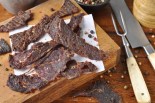Healthy eating almost cost Jason Burke his marriage. Honestly. He became so enamored with crafting his own beef jerky that his wife finally unplugged his meat dehydrators and told him she was tired of her friends always asking her if she’d just come from a BBQ. Her clothes always had a smoky, barbecued scent.
“There was a time when there was nothing in our refrigerator except gallon jars of marinade and raw meat,” said Burke. “My wife was getting frustrated.”
Burke eased the marital tension by removing evidence of his hobby from their kitchen and renting a 200 square-foot catering kitchen. His hobby expanded into an impressive business and his marriage grew even stronger.
Once he moved the operation to a separate facility, he witnessed an amazing transformation. He put up a website almost overnight and without any type of marketing or social media push, people started buying the product and demand exploded.
“I spent the next two years figuring it out,” he said. “I still had my day job and I’d go in the evenings and sell online. I was learning about manufacturing, branding, and how to build a following. In September 2012, I put in my two-week notice and went full-time selling The New Primal.”

The thing that makes The New Primal jerky so appealing is that Burke says it’s the most responsible and cleanest jerky on the market. It has the lowest sugar and sodium per ounce as compared with other brands. Their beef is from 100% grass fed, free range, humanely raised livestock.
He had just moved to Charleston, S.C. four and a half years ago when he got on a health kick. He started a new fitness regime and became more interested in diet and nutrition. He latched onto a paleo primal diet before it became so trendy.
“I wasn’t a big carb guy anyway,” he said. “It was real easy for me to prepare breakfast, lunch and dinner, but in between was rough. I got tired of just having trail mix all the time. I knew jerky was a great snack, but the problem was I couldn’t find jerky that was clean. Everything I looked at was full of salt and full of sugar.”
Related: Learn All About Making Jerky With “The Jerky Bible”
He started making jerky purely for his own healthy snacking, but as he began sharing it with co-workers and friends at the gym, they began asking for more. He went from one dehydrator to six in about six months, giving him a clue for the demand for what he was producing.
The New Primal currently uses two manufacturing facilities—one in southern California and the other in Nebraska. They produce beef jerky (original and spicy), turkey jerky, and jerky plus, which is a combination of beef jerky and trail mix loaded with raw almonds, cashews, and fruit. Retail price for a 4-pack is $26.95 for all varieties. Along with the 100% grass-fed beef, the product is gluten free and produced without artificial ingredients or preservatives.
Next up—the company is considering exploring healthy animal fats. “We’re seeing a demand for lard and beef tallow that people used to cook with and then stopped when they thought canola oil was healthy,” said Burke. “Now it’s coming back. If we can use the entire animal, we will.”


